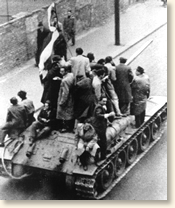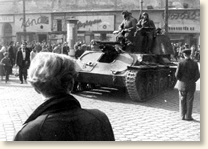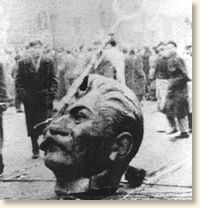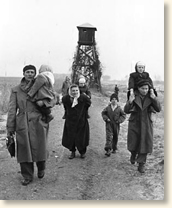|
The Hungarian Revolution, 1956
The Soviet troops that poured into Eastern Europe in 1945 in pursuit of the fleeing German Army were welcomed as liberators by the residents of Poland, Hungary, Bulgaria, Rumania and the other countries in the region. Unfortunately, the euphoria died with the realization that Stalin had no intention of withdrawing from Eastern Europe after the defeat of Nazi Germany.
 |
Citizens capture a Soviet tank
|
The regional frustration with Soviet domination was expressed by approximately 15,000 Polish steelworkers in Poznan when they took to the streets to demonstrate their various grievances in July 1956. The ensuing clash with Soviet troops resulted in the death of 38 workers. However, the riot also prompted a relaxation of centralized Party control in Poland the following October.
The Polish experience inspired the Hungarians to act. On the afternoon of October 23rd an estimated crowd of 50,000 gathered in central Budapest to honor an Hungarian hero. A proclamation declaring independence and demanding the withdrawal of Soviet troops was read. By 8:00 that evening the crowd had grown to over 200,000 and moved to the Parliament Building to express their demands. Rebuffed by the leader of the Communist Party, who labeled the protesters as a "reactionary mob", the crowd surrounded the headquarters of the state radio station in hopes of broadcasting their demands to the nation. The crowd was confronted by the Hungarian Secret Police who had barricaded themselves inside. Growing more angry, the crowd rushed the radio station and were immediately fired upon.
The Hungarian Revolution had begun. The Hungarian Army joined with the citizens. Fighting raged for five days culminating in the expulsion of the Soviet forces from the city. It looked as if the uprising might be successful.
The Soviet leaders in Moscow had other ideas. In the early morning hours of November 4, an infantry force accompanied by artillery and 1000 tanks smashed into the city. By November 7 the uprising had been crushed.
Reporter D. Sefton Delmer filed this eyewitness account of the beginning of the uprising with the London Daily Express:
"I have been the witness today of one of the great events of history, I have seen the people of Budapest catch the fire lit in Poznan and Warsaw and come out into the streets in open rebellion their Soviet overlords. I have marched with them and almost for joy with them as the Soviet emblems in the Hungary were torn out by the angry and exalted crowds. And the point about the rebellion is that it looks like being successful.
As I telephone this dispatch I can hear the roar of delirious crowds made up of student girls and boys, of Hungarian soldiers still wearing their Russian-type uniforms, and overalled factory workers marching through Budapest and shouting defiance against Russia. 'Send the Red Army home,' they roar. 'We want free and secret elections.' And then comes the ominous cry which one always seems to hear on these occasions: 'Death to Rakosi.' Death to the former Soviet puppet dictator - now taking a 'cure' on the Russian Black Sea Riviera - whom the crowds blame for all the ills that have befallen their country in eleven years of Soviet puppet rule.
 |
Soviet troops
|
Leaflets demanding the instant withdrawal of the Red Army and the sacking of the present Government are being showered among the street crowds from trams. The leaflets have been printed secretly by students who 'managed to get access', as they put it, to a printing shop when newspapers refused to publish their political programme. On house walls all over the city primitively stenciled sheets have been pasted up listing the sixteen demands of the rebels.
But the fantastic and, to my mind, really super-ingenious feature of this national rising against the Hammer and Sickle, is that it is being carried on under the protective red mantle of pretended Communist orthodoxy. Gigantic portraits of Lenin are being carried at the head of the marchers. The purged ex-Premier Imre Nagy, who only in the last couple of weeks has been readmitted to the Hungarian Communist Party, is the rebels' chosen champion and the leader whom they demand must be given charge of a new free and independent Hungary. Indeed, the Socialism of this ex-Premier and - this is my bet Premier-soon-to-be-again, is no doubt genuine enough. But the youths in the crowd, to my mind, were in the vast majority as anti-Communist as they were anti-Soviet - that is, if you agree with me that calling for the removal of the Red Army is anti-Soviet.
In fact there was one tricky moment when they almost came to blows on this point. The main body of students and marchers had already assembled outside their university in front of the monument to the poet-patriot Petofi who led the 1848 rebellion against the Austrians. Suddenly a new group of students carrying red banners approached from a side street. The banners showed them to be the students of the Leninist-Marxist Institute, which trains young teachers of Communist ideology and supplies man puppet rulers' civil servants.
The immediate reaction of the main body, I noticed was to shout defiance and disapproval of the oncoming ideologists But they were quickly hushed into silence and the ideologists joined in the march with the rest of them, happily singing the Marseillaise... "
Hungarian journalist George Paloczi-Horvath filed this report with the London Daily Herald:
"It was dawn ... the day the Russians struck again.
We were awakened by the roar of heavy guns. The radio was a shambles. All we got was the national anthem, played over and over again, and continual repetition of Premier Nagy's announcement that after a token resistance we must cease fighting and appeal to the free world for help. . .
 |
The mob attacks a bust of Stalin
|
After our ten days' war of liberty; after the pathetically short period of our 'victory', this was a terrible blow. But there was no time to sit paralysed in despair. The Russians had arrested General Maleter, head of the Central Revolutionary Armed Forces Council The Army had received ceasefire orders. But what of the fighting groups of workers and students?
These courageous civilian units now had to be told to put td only token resistance in order to save bloodshed. They had been instructed not to start firing.
I called up the biggest group, the 'Corvin regiment.' A deputy commander answered the phone. His voice was curiously calm: 'Yes, we realized we should not open fire. But the Russians did. They took up positions around our block and opened fire with everything they had. The cellars are filled with 200 wounded and dead. But we will fight to the last man. There is no choice. But inform Premier Nagy that we did not start the fight.'
This was just before seven in the morning. Premier Nagy, alas, could not be informed any more. He was not to be found.
The situation was the same everywhere. Soviet tanks rolled in and started to shoot at every centre of resistance which had defied them during our first battle for freedom.
This time, the Russians shot the buildings to smithereens. Freedom fighters were trapped in the various barracks, public buildings and blocks of flats. The Russians were going to kill them off to the last man. And they knew it. They fought on till death claimed them.
 |
A family flees across
the Hungarian border
|
This senseless Russian massacre provoked the second phase of armed resistance. The installation of Kadar's puppet government was only oil on the fire. After our fighting days, after our brief span of liberty and democracy, Kadar's hideous slogans and stupid lies, couched in the hated Stalinite terminology, made everyone's blood boil. Although ten million witnesses knew the contrary, the puppet government brought forward the ludicrous lie that our war of liberty was a counter-revolutionary uprising inspired by a handful of Fascists.
The answer was bitter fighting and a general strike throughout the country. In the old revolutionary centers - the industrial suburbs of Csepel, Ujpest and the rest - the workers struck and fought desperately against the Russian tanks. . .
Armed resistance stopped first. The Russians bombarded to rubble every house from which a single shot was fired. The fighting groups realized that further battles would mean the annihilation of the capital. So they stopped fighting.
But the strike went on.
The Workers' Councils, the Writers' Association and the Revolutionary Council of the Students decided at last that the general strike must be suspended if Hungary were not to commit national suicide. . ."
References:
D. Sefton Delmer's account appears in the London Daily Express, Oct. 23, 1956;
George Paloczi-Horvath's account appears in the London Daily Herald, Nov. 4, 1956; Sebestyen, Victor, Twelve Days: The Story of the 1956 Hungarian Revolution (1996).
How To Cite This Article:
"The Hungarian Revolution, 1956" EyeWitness to History, www.eyewitnesstohistory.com
(2009).
|






